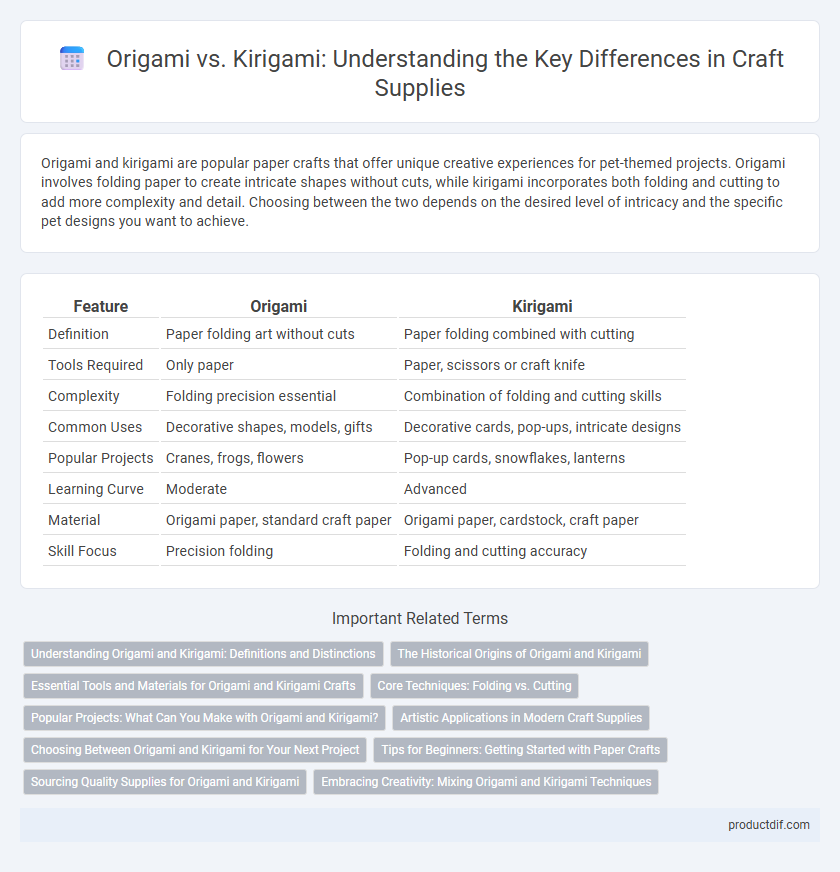Origami and kirigami are popular paper crafts that offer unique creative experiences for pet-themed projects. Origami involves folding paper to create intricate shapes without cuts, while kirigami incorporates both folding and cutting to add more complexity and detail. Choosing between the two depends on the desired level of intricacy and the specific pet designs you want to achieve.
Table of Comparison
| Feature | Origami | Kirigami |
|---|---|---|
| Definition | Paper folding art without cuts | Paper folding combined with cutting |
| Tools Required | Only paper | Paper, scissors or craft knife |
| Complexity | Folding precision essential | Combination of folding and cutting skills |
| Common Uses | Decorative shapes, models, gifts | Decorative cards, pop-ups, intricate designs |
| Popular Projects | Cranes, frogs, flowers | Pop-up cards, snowflakes, lanterns |
| Learning Curve | Moderate | Advanced |
| Material | Origami paper, standard craft paper | Origami paper, cardstock, craft paper |
| Skill Focus | Precision folding | Folding and cutting accuracy |
Understanding Origami and Kirigami: Definitions and Distinctions
Origami is the traditional Japanese art of paper folding, transforming a flat square sheet into intricate three-dimensional designs without cutting or gluing. Kirigami, by contrast, incorporates precise cutting techniques alongside folding to create more complex and detailed paper sculptures. The key distinction lies in origami's pure folding approach versus kirigami's combination of cutting and folding, offering varied creative possibilities in craft supply projects.
The Historical Origins of Origami and Kirigami
Origami traces its historical origins to 17th-century Japan, where it developed as the art of paper folding without cutting, deeply rooted in ceremonial and cultural practices. Kirigami, emerging later, incorporates both folding and cutting paper, with influences from traditional Japanese and Chinese paper-cutting techniques dating back to the Edo period. Both crafts reflect centuries-old artistic traditions but differ fundamentally in their manipulation of paper, shaping distinct creative expressions within the craft supply community.
Essential Tools and Materials for Origami and Kirigami Crafts
Origami requires only square paper and patience, emphasizing precision folds without any cutting tools to create intricate designs. Kirigami involves both folding and cutting, necessitating additional materials such as a craft knife, cutting mat, and ruler to achieve detailed patterns. Both crafts benefit from high-quality paper that holds creases well, but kirigami demands sturdier paper to withstand cuts without tearing.
Core Techniques: Folding vs. Cutting
Origami centers on transforming paper through precise folding techniques, creating intricate designs without any cuts, emphasizing symmetry and structure. Kirigami incorporates both folding and cutting, allowing for more complex three-dimensional shapes and detailed patterns that unfold from the paper. Mastery in origami requires control over creases and tension, while kirigami demands skillful cutting alongside folding precision to achieve dynamic and elaborate crafts.
Popular Projects: What Can You Make with Origami and Kirigami?
Origami enables the creation of intricate paper cranes, modular boxes, and decorative flowers through precise folding techniques. Kirigami expands design possibilities by incorporating cutting, allowing for pop-up cards, intricate snowflakes, and detailed three-dimensional sculptures. Both crafts offer versatile project ideas, with origami emphasizing folds and kirigami combining folds and cuts for dynamic paper art.
Artistic Applications in Modern Craft Supplies
Origami and kirigami both transform paper into intricate designs, but origami relies solely on folding while kirigami incorporates cutting techniques, broadening artistic possibilities. Modern craft supplies include specialty papers with varying textures and colors, enhancing the precision and aesthetics of these crafts. Artists use these techniques to create unique decorations, wearable art, and three-dimensional models, making them versatile tools in contemporary paper crafting.
Choosing Between Origami and Kirigami for Your Next Project
Origami involves folding paper without cutting, making it ideal for projects emphasizing intricate folds and minimal tools, while kirigami combines folding and cutting, allowing for more complex designs and shapes. Choosing between origami and kirigami depends on the desired complexity and detail of your craft, with origami suited for geometric and structural forms, and kirigami better for decorative and dimensional effects. Selecting quality origami paper or kirigami blades enhances precision and overall project outcome, ensuring professional results for both techniques.
Tips for Beginners: Getting Started with Paper Crafts
Origami and Kirigami both offer unique paper crafting experiences, with origami focusing on folding techniques and kirigami incorporating cutting for intricate designs. Beginners should start with basic origami models like cranes or boats to build folding skills, while kirigami novices can practice simple cut patterns using precision scissors and sharp blades. Using high-quality, acid-free paper enhances durability, and following step-by-step tutorials helps ensure clean folds and cuts for polished results.
Sourcing Quality Supplies for Origami and Kirigami
Sourcing quality supplies for origami and kirigami is crucial for achieving precision and durability in paper crafts. Origami demands smooth, crease-friendly papers like kami or washi for clean folds, while kirigami requires slightly sturdier paper to hold intricate cuts without tearing. Premium tools such as sharp scissors or craft knives and resin-coated papers enhance the detail and longevity of both art forms.
Embracing Creativity: Mixing Origami and Kirigami Techniques
Blending origami's precise folding with kirigami's intricate cutting techniques unlocks new dimensions in paper crafting creativity. This fusion allows artists to create dynamic, three-dimensional designs that combine structural elegance with delicate patterns. Embracing both methods expands the potential for innovative craft projects, enhancing texture, depth, and visual interest.
Origami vs Kirigami Infographic

 productdif.com
productdif.com